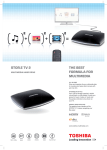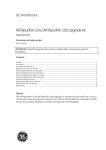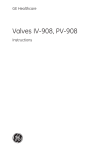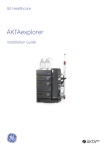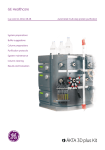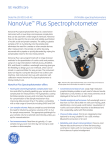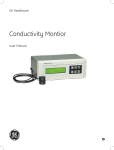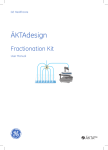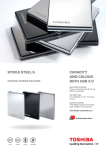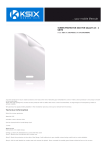Download Flanging/Start Up Kit - GE Healthcare Life Sciences
Transcript
GE Healthcare Short Instructions 56-0426-00 AO Flanging/Start Up Kit Flanging/Start Up Kit (Code No. 19-5079-01, 120 V and 19-5090-01, 230V) is used to flange tubing ends (0.5–0.8 mm i.d.) so that the tubing is retained inside the tubing connector. With the flanging kit it is possible to prepare tubing of any length to fit a specific system. The Flanging heater is based on a standard soldering iron with a special tip for flanging of capillary tubings. Flanges are made by pushing the capillary tubing onto the heated flanging tip. As the tubing heats up it flares out; the flanging tip is removed and the tubing is pressed against a flat, cool surface in order to fix the flange. Safety WARNING! Hot-surface. Risk for fire or injury if soldering tip or element is not handled with care. WARNING! A fire may result if the appliance is not used with care, therefore; - be careful when using the appliance in places where there are combustibles - do not apply to the same place for a long time - do not use in the presence of an explosive atmosphere Check the packing list to ensure receipt of all necessary parts. - be aware that heat may be conducted to combustible materials Important user information - place the appliance on its stand after use and allow it to cool down Meaning: Consult the instruction manual to avoid personal injury or damage to the product or other equipment. Meaning: Hot surface. Risk of injury and fire. - do not leave the appliance unattended when it is switched on. Please read the instruction leaflet delivered with the soldering iron for safe use of the flanging heater. WARNING! WARNING! Connect to grounded mains outlet only. The WARNING! sign is used to call attention to the necessity to follow an instruction in detail to avoid personal injury. Be sure not to proceed until the instructions are clearly understood and all stated conditions are met. WARNING! Be careful when removing hot cooling collars. Disconnect the device and wait 15 minutes before changing the cooling collar! CAUTION! Selecting the proper cooling collar The CAUTION! sign is used to call attention to instructions or conditions that shall be followed to avoid damage to the product or other equipment. Be sure not to proceed until the instructions are clearly understood and all stated conditions are met. Mains voltage differences cause temperature variations in the flanging tool’s tip. With certain voltages the tip becomes overheated and it melts the tubing.To solve this problem there are two cooling collars used singly or together for different mains voltages. Use the appropriate collar or collars depending on the main voltage from Table 1. Note The Note sign is used to indicate information important for trouble free or optimal use of the product. Should you have any comments on this instruction, we will be pleased to receive them at: GE Healthcare Bio-Sciences AB, SE-751 84 Uppsala, Sweden WARNING! Be careful when removing hot cooling collars. Disconnect the device and wait 15 minutes before changing the cooling collar! Table 1. Mains voltage and recommended cooling collars. Technical specification Mains voltage/volts Cooling collars Power requirements 90 110 120 132 198 220 240 264 unnecessary B (10 mm) A+B (15 mm) A+B (15 mm) unnecessary A (5 mm) B (10 mm) A+B (15 mm) 100–120 V ~ (AC) Model 19-5079-01 220–240 V ~ (AC) Model 19-5090-01 Frequency 50–60 Hz Power consumption 14 W Safety standards This product meets the requirements of the Low Voltage Directive (LVD) 73/23/EEC through the harmonized standards EN60335-2-45 How to make a flange Note: The declaration of conformity is valid for the instrument when it is: 1. Heat the flanging tool for at least 20 minutes before use. • used in laboratory locations, 2. Cut with a sharp blade at a 90° angle the appropriate length of capillary tubing. • used in the same condition as it was delivered from GE Healthcare except for alterations described in the user manual, 3. Thread the tubing through the nipple screw and the nipple (figure 1). 4. Grasp the tubing with the tubing clamp behind the nipple. Insert the tubing into the small hole in the black support on the flanging tool (figure 2), and slide the nipple up to the support. Reposition the clamp closely behind the nipple. This ensures that the correct length of tubing (1.5 mm) protrudes for flanging. 5. Position the tubing end onto the flanging tip. Make sure the tubing end is parallel to the flat surface of the flanging tip (figure 3). 6. Push the 1.5 mm of tubing onto the flanging tip projection and heat for about 5 seconds. Then push hard until the heated 1.5 mm of protruding tubing flares out against the flanging tip base (figure 4). 7. Remove the tubing from the flanging tip and press the newly formed flange against a flat, cool surface (figure 5). 8. Ensure that the flange is not narrower than the tubing by inserting the flanging tip briefly into the tubing. 9. The flange is now finished (figure 6). It should be concentric with the tubing bore and slightly smaller than the diameter of the tubing nipple. • used as a “stand alone” unit Maintenance CAUTION! Only spare parts approved or supplied by GE Healthcare may be used for maintaining and servicing of Flanging heater. The supply cord cannot be replaced. If the cord is damaged the appliance should be scrapped. Read the instruction leaflet delivered with the soldering iron for maintenance of the flanging heater. Spare parts CAUTION! Only spare parts approved or supplied by GE Healthcare may be used for maintaining and servicing of Flanging heater. Designation Code No. No. per pack Flanging heater 120 V 19-5080-01 1 or 220 V 19-5098-01 1 Flanging tip 19-7487-01 1 Tubing clamp 19-7844-01 1 Cooling collars (A+B) 19-7825-01 2 Accessories 2 Short Instructions 56-0426-00 AO Designation Code No. No per pack Capillary tubing (o.d. 1.8 mm, i.d. 0.5 mm) 19-7477-01 2m Tubing (o.d. 1.7 mm, i.d. 1.1 mm) 19-0041-01 5m Tubing connectors 19-7476-01 5 Wrench 19-7481-01 1 Troubleshooting Problem Solution 1. Flange is uneven Center the flanging tip in the tubing bore. Heat the tubing for 5 seconds, no longer. Excessive heating could cause the tubing to melt unevenly. Make sure the tubing has been cleanly cut to a 90° angle. 2. Diameter of flange is too small When heating the tubing be sure the entire 1.5 mm of tubing is on the flanging tip projection. Heat the flanging tool for at least 20 minutes before use. 3. Tubing end does not start easily onto the flanging tip Heat the flanging tool for at least 20 minutes before use. Make sure the tubing has been cleanly cut to a 90° angle. 4. Flange rolls back on itself The correct length of tubing protuberance is important; it should be 1.5 mm. 5. Tubing protuberance bends and collapses when pushed onto flanging tip Measure tubing protuberance (see solution no. 4). Flange Nipple screw Nipple Tubing Fig 1. Nipple screw and nipple on tubing. Fig 3. Tubing end parallel with flanging tool surface. Fig 5. Pressing the warm flange against a cool, flat surface. Fig 2. Measuring the tubing protuberance. Fig 4. Tubing end pushed against the flat surface of the flanging tip. Fig 6. Completed tubing flange. Short Instructions 56-0426-00 AO 3 www.gehealthcare.com GE Healthcare Bio-Sciences AB Bjorkgatan 30 751 84 Uppsala Sweden GE, imagination at work and GE monogram are trademarks of General Electric Company © 2006 General Electric Company – All rights reserved. All goods and services are sold subject to the terms and conditions of sale of the company within GE Healthcare which supplies them. A copy of these terms and conditions is available on request. Contact your local GE Healthcare representative for the most current information. GE Healthcare Bio-Sciences AB Bjorkgatan 30, 751 84 Uppsala, Sweden GE Healthcare Europe GmbH Munzinger Strasse 5, D-79111 Freiburg, Germany GE Healthcare UK Limited Amersham Place, Little Chalfont, Buckinghamshire, HP7 9NA, UK GE Healthcare Bio-Sciences Corp. 800 Centennial Avenue, P.O. Box 1327, Piscataway, NJ 08855-1327, USA GE Healthcare Bio-Sciences KK Sanken Bldg. 3-25-1, Hyakunincho Shinjuku-ku, Tokyo 169-0073, Japan Elanders Östervåla 2006 Asia Pacific Tel: +85 65 62751830 Fax: +85 65 62751829 • Australasia Tel: +61 2 8820 8299 Fax: +61 2 8820 8200 • Austria Tel: 01 /57606 1613 Fax: 01 /57606 1614 • Belgium Tel: 0800 73 890 Fax: 02 416 8206 • Canada Tel: 1 800 463 5800 Fax: 1 800 567 1008 • Central, East, & South East Europe Tel: +43 1 972 720 Fax: +43 1 972 722 750 • Denmark Tel: +45 70 25 24 50 Fax: +45 45 16 2424 • Eire Tel: 1 800 709992 Fax +44 1494 542010 • Finland & Baltics Tel: +358 9 512 3940 Fax: +358 9 512 39439 • France Tel: 01 69 35 67 00 Fax: 01 69 41 98 77 • Germany Tel: 0800 9080 711 Fax: 0800 9080 712 • Greater China Tel: +852 2100 6300 Fax: +852 2100 6338 • Italy Tel: 02 26001 320 Fax: 02 26001 399 • Japan Tel: 81 3 5331 9336 Fax: 81 3 5331 9370 • Korea Tel: 82 2 6201 3700 Fax: 82 2 6201 3803 • Latin America Tel: +55 11 3933 7300 Fax: +55 11 3933 7304 • Middle East & Africa Tel: +30 210 96 00 687 Fax: +30 210 96 00 693 • Netherlands Tel: 0800-82 82 82 1 Fax: 0800-82 82 82 4 • Norway Tel: +47 815 65 777 Fax: +47 815 65 666 • Portugal Tel: 21 417 7035 Fax: 21 417 3184 • Russia & other C.I.S. & N.I.S Tel: +7 495 956 5177 Fax: +7 495 956 5176 • Spain Tel: 902 11 72 65 Fax: 935 94 49 65 • Sweden Tel: 018 612 1900 Fax: 018 612 1910 • Switzerland Tel: 0848 8028 10 Fax: 0848 8028 11 • UK Tel: 0800 515 313 Fax: 0800 616 927 • USA Tel: +1 800 526 3593 Fax: +1 877 295 8102 imagination at work 56-0426-00 AO 12/2006




